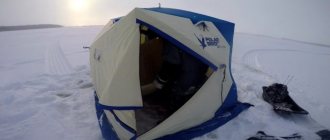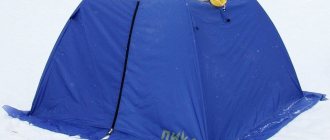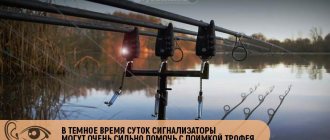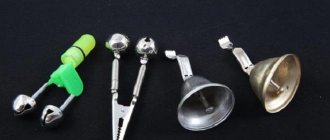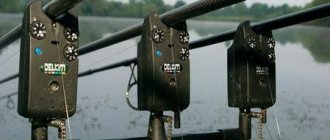Heating » Premises » Others
Published March 14, 2015 at 0:45 am
Interest in active recreation, which, in particular, includes multi-day cycling and hiking trips, kayaking, fishing (including winter), does not wane. And when planning such an event, it is necessary to provide for various situations that may arise away from home, and various items and devices may be needed to resolve them. And among the important ones are, for example, how to provide protection during a sudden change in weather (in the summer) or heating a tent (in the cold months), because... Not only comfort, but also human health will depend on such measures.
It should be noted that a rare hike, fishing, etc., designed for more than one day, can be done without a tent, which provides protection from the sun, wind, rain, cold, and also allows you to rest both during the day and at night. Therefore, the issue of organizing heat in it can be called relevant and quite interesting.
Today, there are a large number of ways to solve this problem and which are presented in abundance in discussions, videos, and information materials on the Internet. Summarizing the data, all options can be divided into two groups:
- heating using improvised materials or items included in the necessary tourist kit - such options are usually elementary, and the simplest “heaters” are easy to make with your own hands;
- heat supply using special devices (for example, gas burners, mobile stoves, lamps, etc.).
How to choose a tent heater
It is generally accepted that tourists, fishermen and simply lovers of outdoor recreation are unpretentious people: they are not afraid of snow and rain, and they can spend the night anywhere. In fact, everyone loves comfort, some are just too lazy to create it.
Tourists are creative people and approach the issue of heating a tent head-on. After all, taking care of high-quality heating of the tent, especially in the cold season, is not a whim, but a necessity, the failure of which is fraught with unpleasant consequences for health.
There are several options to solve this problem:
- buy a heater;
- use available means for heating;
- make a stove with your own hands.
Portable ovens
Example of a portable tent stove
There are homemade and industrial stoves for heating tents. They operate mainly on solid fuel. These are the familiar “potbelly stoves” that are suitable for a large tourist group. They are indispensable in extreme tourism. But they take up enough space and require chimney installation and constant attention.
This pays off with high heat transfer, but their dimensions and weight are not for small tents.
How to heat a tent using improvised means?
To solve the problem you need a coolant.
It could be:
- an open source of fire, enclosed in a casing;
- heated heat-intensive material.
The second option is more accessible on a hike and is safer. We will talk about stones that perfectly retain heat. However, if you bring a hot stone into a tent, it will immediately heat up very much, but after an hour there will be no trace of the heat left. Therefore, care must be taken to increase the thermal inertia of the stone: it must release heat slowly.
For this you will need a thermal insulator. The best option is foil. In the first hours, it will protect the tent from overheating and its inhabitants from burns. A well-heated stone is wrapped in several layers of foil and placed in a pan of suitable size. The more layers of foil, the stronger the thermal insulation, and the longer the stone will heat the tent.
If it gets cool in the tent in the morning, you can remove some of the foil and the tent will become warm again. This is a proven method of lawyer Egorov, famous for his travel life hacks. He suggests choosing a stone the size of a human head and choosing a pan so that the stone does not touch the bottom. This entire structure must be placed in a tent on a board or other insulating material.
Using hot stones
How to heat a tent in the fall, when the air temperature is not too low? The best and easiest option is to throw a couple of stones into the fire to get them hot. Finding them won't be difficult. You can take several stones if they are small. If you can find a large cobblestone, then one will be enough.
So, you need to carefully place the stones in the fireplace and wait for them to warm up. After this, you need to remove them, and then wrap them in foil, if you have it in your inventory. In a camping tent, in the place where the so-called heater will be installed, you need to mount a simple structure: put a few branches or a board. This moment must not be missed, otherwise burning stones may damage the bottom of the tent. Place a cauldron on the structure, in which the heated cobblestones will eventually lie.
Simplicity and long-term heat transfer are the advantages of this heating design. The downside is the danger of damaging the tent. How to heat a tent without getting burned yourself? You must be extremely careful and attentive in this matter.
keeping warm in a tent
To retain heat, the initial conditions for setting up the tent are important, and choosing a wisely chosen location will save you a lot of effort.
It should be dry (do not place it in swampy areas!), away from water (near a river or lake the temperature is always lower), protected from the wind, but if we are talking about mountains, not under stones.
Following these simple rules will protect you from the cold and many dangers. In addition, the tent can be placed on a fire pit. If this is not possible, the tent should be raised above the ground using available means. Ideal if it is spruce branches, or just tree branches. It will be warmer on such an air cushion. Of course, there is a risk of not getting enough sleep, and such a “bed” will be quite hard, but it’s still better than frostbitten kidneys.
So, how are we going to keep warm?
Warming up the earth
Now we’ll find out how to heat a tent while camping in severely cold conditions. An old and reliable way is to put up a tent on the site of the fire. There are two options here. The first takes more time and energy. First, in the place where the tent will be installed in the future, you need to remove the turf. You should dig to a depth of 20 centimeters. Then a huge fire with wide logs is built in this pit. The main goal at this stage is to dry and warm the earth, as well as to obtain large coals. When the coals are ready, they are evenly distributed over the pit and covered with a 7-10 cm layer of earth.
It is important that the soil is dry. If there is none, you need to use the second method below
Dry grass or spruce branches are laid on the ground, and a tent is placed on top. The tent is heated throughout the night.
The second option is less energy intensive. In this case, there is no need to dig a hole. All you need to do is light a large fire, and when it burns out, carefully remove the coals to the side. Spruce branches are laid on the ground hot from the fire and a tent is pitched.
Gas heaters
In this video, they will tell you how to use gas tent heaters correctly. Enjoy watching!
This is the most popular type of heating. Here prices are in the range of 2000 - 7000 rubles. There are several types of such devices. They are heated by a gas cylinder and have various heating elements that allow you to control the temperature.
According to the type of heat emitter they are divided into:
- ceramic infrared;
- heaters with a metal emitter;
- catalytic gas heaters.
There are two types of design: the burner is connected to the cylinder through a special hose, or the burner is placed on the cylinder. They all differ in working volume. There are models designed for 2 - 3 hours of operation without refueling, others work longer.
Infrared heaters with ceramic element
The operating principle is based on converting the heat of the burner into infrared radiation with high efficiency.
Their advantages:
- small size and weight;
- efficiency;
- release of a minimum amount of harmful substances;
- versatility;
- safety.
Power of ceramic models: 0.5 – 1.75 kW. Cost: 2000 – 4000 rub.
Heaters with metal emitter
Type of heater with a metal emitter
Outwardly, they resemble a cap made of steel mesh. This is a protective screen that separates the hot burner. A parabolic reflector is installed behind it. Such stable burners are capable of creating comfortable temperature conditions over large areas. Configurations of this type can be equipped with one or two burners.
But their efficiency is lower than that of the previous type. If for ceramic ones it is up to 50%, then here the maximum figure is 30%. The fuel consumption of such burners is also higher. It should be remembered that they do not heat much better.
Catalytic gas heater
This design uses a fiberglass panel. A layer of patina is applied to it, which is a combustion catalyst. These are the most efficient burners. The efficiency of such devices is about 100%.
Such heaters are chosen by those who are environmentally friendly: the fuel burns without flame. The device heats the air quickly, operates silently, and is the safest in terms of sudden ignition.
The cost of such devices is 1000 rubles. (for small heating pads), and 3000 - 7000 rubles. for more powerful heaters. The disadvantages include the desire of manufacturers to make the components of this heater as in demand as possible.
They cannot be replaced with similar ones; for most, only “original” cartridges are suitable. The disadvantage of all gas heaters is failures when operating in severe frosts. You may need to insulate or heat the cylinder.
Types of heat exchangers for tents
The design of heat exchangers may differ slightly, but the general principle of operation is the same for all devices. The classification of these devices is based on the type of heating source. The most popular types of such heaters are described below.
Candles and alcohol burners
The simplest version of a heat exchanger, capable of maintaining a one-person tent in a more or less warm state, under conditions of an average daily air temperature of at least -5°C. The power of the device for heating larger rooms, as well as for use at lower temperatures, will not be enough. Such a device can be made from two tin cans of condensed milk, with the top carefully cut off.
Find out how to heat the soil in a greenhouse.
Solid fuel
Gasoline heat exchanger
This type of heater has been known for quite some time, and its design has not undergone significant changes over time. The popularity of such units is explained by the specific cheapness of the heat generated, in comparison with other types, regardless of gasoline prices. This hydrocarbon has a very high energy intensity and, when used correctly, 1 liter of fuel can maintain heat in a small tent for a very long time.
We advise you to find out how to heat a greenhouse with gas.
As for the disadvantages, two main ones can be distinguished: the first is the smell of fuel and combustion products characteristic of such stoves. The second is special safety requirements. A poorly cleaned burner can cause an explosion and fire.
Gas heat exchanger
Did you know? On May 29, 1953, a team of British climbers reached the summit of Qomolungma (Everest) for the first time in history, simultaneously breaking the ascent and summit altitude records. It is no longer possible to break these records in principle, since there are no higher mountains on our planet.
For example, in popular winter fishing spots (people periodically leave and come, you can call and agree on fuel delivery). In addition, as with gasoline heaters, you should be extremely careful with gas-powered devices in terms of following safety regulations.
Clothes and sleeping bag
An important role in the matter of heating is played by the tourist’s clothing, his sleeping bag and mattress. If all these attributes are selected correctly and made with high quality, then they will be enough to comfortably spend the night in the autumn forest. However, with the arrival of real cold weather, such warmth will not be enough. There will also be little of it for children, and there are two reasons for this. Firstly, children get colder. And secondly, they like to toss and turn in their sleep
Therefore, when camping with children, it is important to heat the entire tent.
By the way, if you sleep in a sleeping bag, and in principle, in any other case, try to make sure that the parts of your body are in contact with each other as much as possible. At a minimum, take your arms out of your sleeves. The principle of a mitten works here, which, as you know, warms (or, more correctly, retains body heat) much more effectively than a glove. To make your night in your sleeping bag warmer before the harsh cold sets in, a simple bottle of hot water, which you need to take with you in your bag, will help. You will get a kind of heating pad.
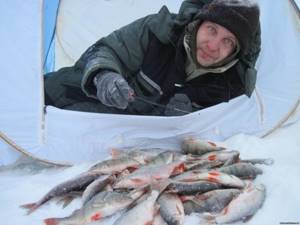
Good for everyone: weight, speed of disassembly and assembly, easily enough for three seasons... Minus: low in height and bends in strong winds. But its price negates these shortcomings, compared to other large tents, which cost significantly more. I have had it for a long time and it has helped me out in various weather situations. At first, like everyone else, I tried to heat it with household candles, but it was very inconvenient. Candles without fixation are always ready to fall; it is difficult to install vertically on an uneven surface under a tent; as a result, they burn out quickly, and stains from melted paraffin remain on the floor of the tent. And the effect of one candle is not enough, it even turns out worse... Steam from breathing... If you don’t string bloodworms, you can’t see the fishing line, as a result, an increase in temperature of two to four degrees is eaten up by the effect of steam that interferes with the visibility and the need to monitor the vertical installation of the candle. I decided to improve the heating of the tent with candles, or rather their design:
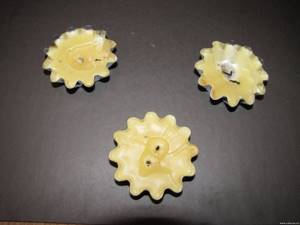
I bought molds, melted the paraffin, installed two or three wicks in each in the hope that this solution would eliminate all the shortcomings of the previous version. But the effect remained approximately the same: the temperature in the tent increased slightly, and the steam from the breath remained. The only plus is that the wax burned out completely in the mold, the candle did not fall and, as a result, there were no paraffin drops at the bottom of the tent. In parallel, I tried using dry fuel for heating:
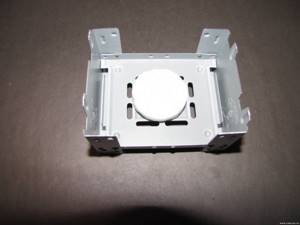
On the one hand, it’s better than candles: The temperature in the tent has increased, nothing drips onto the floor, but... There are significant disadvantages. Dry fuel smokes and emits a lot of carbon monoxide; you have to ventilate it to avoid headaches. Another downside is that the tablets burn out quickly; on average, you have to refill the next one every ten minutes. As a result, you can’t concentrate on fishing; in addition to controlling the nod, you always have to be often distracted by the combustion process... This heating option didn’t suit me either... I need to look for something else... On the Internet I somehow came across videos on the use of alcohol burners by “bourgeois” for heating and heating water. How cool... Apparently, this is exactly what I need... I thought at first... And he began to peel and make holes in all sorts of cans, building alcohol heaters:
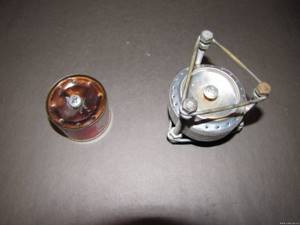
I made a lot of things... of different designs...
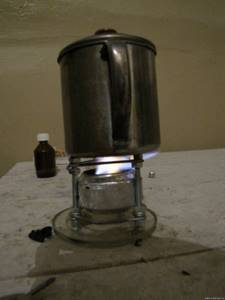
During testing on the staircase of the entrance, this burner design showed good results in terms of heat transfer and combustion time.
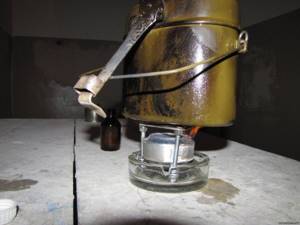
But in field conditions, this option proved to be very inconvenient to use. Firstly, there is a difficulty: you need to heat a container of alcohol until vapor appears, which is not so easy in the cold and dangerous in a tent. Secondly, the difficulty and precision in filling the container: if you fill it too little, it doesn’t burn for long; if you fill it too much, the liquid begins to boil and splash out, which can lead to the tent catching fire. Thirdly, it is problematic to extinguish such a structure urgently (it is impossible to blow it out), just wait until it burns out completely. After seeing the fire hazard of this structure in real life (once after liquid boiled and splashed out on the floor, the three of us urgently evacuated, or rather, jumped out of the tent, almost tearing it apart). As a result, an alcohol burner was not suitable for our conditions for use while fishing... It’s better to take alcohol internally for warming up... Both the body is warm and the soul feels good... And somehow, on a not very catchy hole, at a temperature of minus 25 outside, heating the tent with dry fuel for 50-70 rubles. per pack, changing tablets every 10-12 minutes and breathing paraffin fumes, a thought came to my head: something needs to be changed... The previously tested heaters are not satisfactory... Having scoured the Internet, I came across a solution: an infrared gas tent heater, but of impressive size ...And it’s called compact...
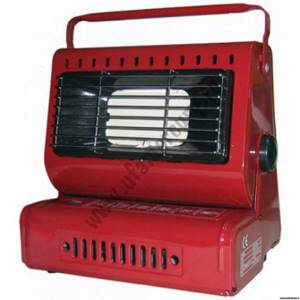
But it’s difficult to carry such a halabuda with you on foot (it weighs more than 2 kg), and it costs, accordingly, from 1500 to 3000 rubles... I looked again: experienced fishermen recommend using a regular gas burner-stove:
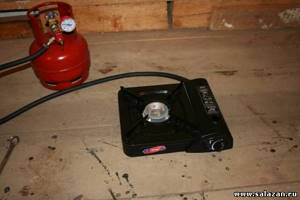
Or this:
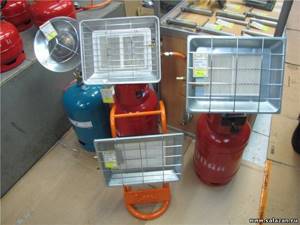
But all this is not suitable for those who like to search for fish on foot, they are heavy... We need to find an easier type:

The burner is beautiful, well, simply good, and so is the price... under 2000 or more rubles. Not our price... I still caught fire with a gas heater for the tent... User reviews simply recommend... In the end, I found what I was looking for - an inexpensive nozzle for a gas cylinder:
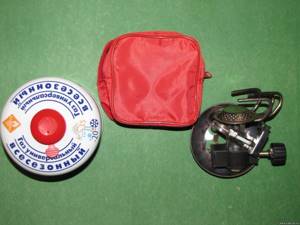
This is a disassembled burner. The price is only 225 rubles. (ours!)... It is carried assembled in a small bag, designed by default for mounting on a threaded gas cylinder (130-150 rubles).
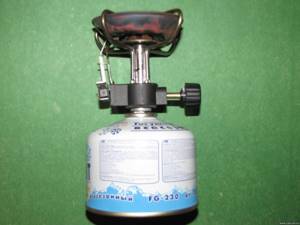
When using an adapter, this burner can also be mounted on collet cylinders (they are cheaper, 45-55 rubles).
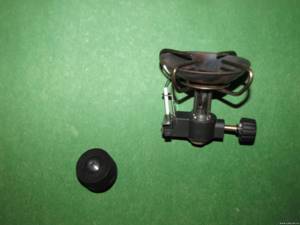
I bought the adapter separately at the nearest fishing store (130-170 rubles)
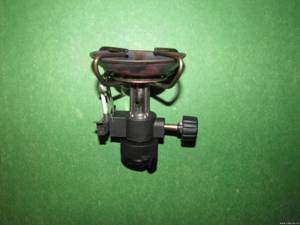
This is a torch on a collet cylinder with an adapter to the torch assembly

And here under steam, the gas is lit... Tests were carried out in a cold interfloor space. In operating mode, the burner produces heat, but not very much...
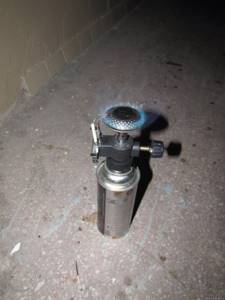
In the end, I realized: the burner is designed by the manufacturers to heat containers located directly above the burner flame, and not to heat the room... It is necessary to increase its efficiency of heat transfer to the surrounding space, or rather for heating. To do this, it is necessary to attach a mesh heat dissipator to the burner of the following type:

There is a ready-made one for sale. But again, it is expensive (900-1200 rubles). We'll do it ourselves... I picked up the necessary tools:
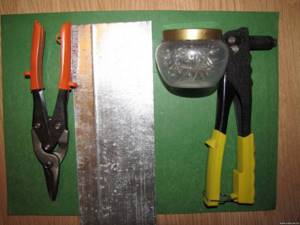
For the primary semicircular flame diffuser, I found and bought an ordinary household strainer:

Fasteners for the burner, from pieces cut according to a galvanized template:
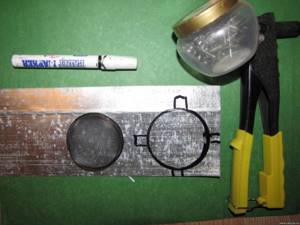
You just mark it, take a small supply and cut it out...
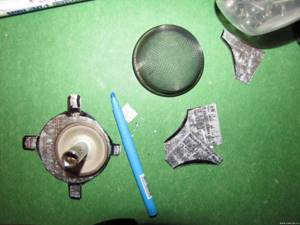
This is what happened:
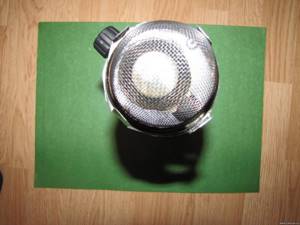
This is with an adapter for a collet cylinder.

When the gas was lit, the effect of heat dissipation was achieved, but the heat around was not as good as we would like. In the end, I decided to finish it... I saw a metal mesh from my neighbor in the garage and begged him (many thanks to him)...
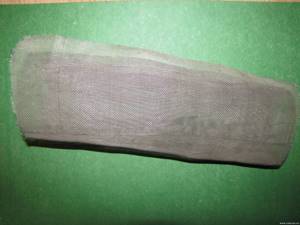
To fit the dimensions, I cut a piece of the required size from galvanized steel with metal scissors:

Applying a “strainer” to the sheet, I noted the required dimensions of the top and bottom and cut it off:
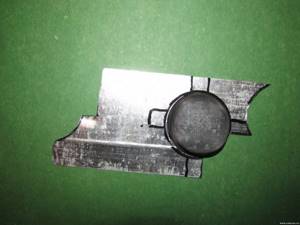
On the top platform I drilled 3 mm holes around the perimeter for greater traction:

Bent the fasteners, placing them on the mesh,

And fastened it with rivets.

When finished, I checked it on a collet cylinder...
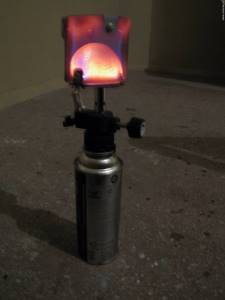
and onto a threaded gas cylinder
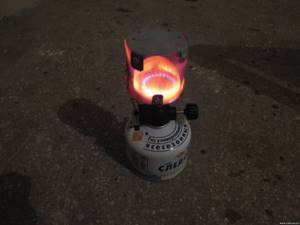
The heat transfer effect exceeded all expectations... From a conventional burner without a nozzle, the heat is felt only at this approach:
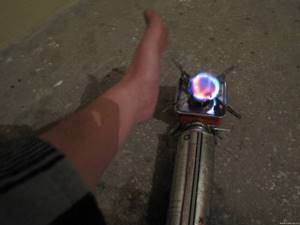
And with the infrared attachment, your hand already burns at this distance:
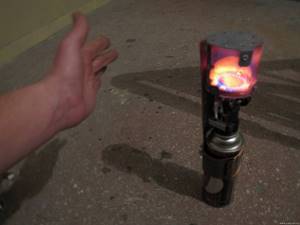
It is simply impossible to bring your hand close (as to a simple gas burner) to a homemade infrared heater. I tested, as I already mentioned, in the entrance, as a result of working for 30 minutes, a significant increase in the ambient temperature was felt. It looks like the infrared burner is ready, I need to try it fishing... In the end I took it plus two cylinders, one collet, the other threaded. The exit was on the first ice, so the walk from the shore to the holes took more than an hour. We found fishing holes for perch and set up tents. But while we were walking, the cylinders froze (it was -15 outside, and they were lying in a fishing box...) It was not possible to light the collet at all. The threaded one (according to the instructions it works at temperatures down to -20 degrees) gave a fire in the burner, but weakly, it siphoned more gas, in the end it was turned off so as not to inhale in the tent... As a result, I got a problem with the gas freezing in the cylinders at low temperatures. It was necessary to solve it somehow... After returning from fishing, I turned to the forum, and there I found an option: We need a passive cylinder heater that uses direct heat from the burner... First, I decided to save money by using large-section copper wire for heating:
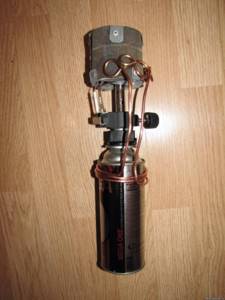
But this design did not cope with its tasks; the heat, even in “accessible” conditions, did not bring the cylinder to the required operating temperature. In the end, I tried this temporary structure: a copper busbar screwed to a cylinder.
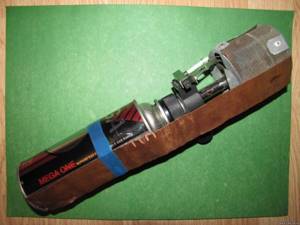
The effect was: after half an hour of burning, this design reached the desired mode... In the future, I will not consider threaded cylinders for winter fishing, since they are expensive and it is not easy to heat them. I modified it and attached a quick-release fastener to the cylinder to the plate:
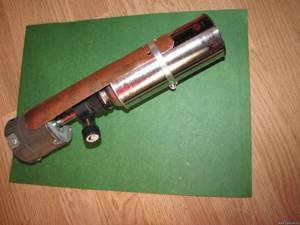
There is an effect... The burner burns and gives heat...
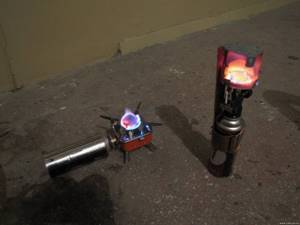
PS Design improvements and upgrades in the next article... Addition (additions) to the article for today:
I accidentally came across a stand for a cylinder in a fishing store:
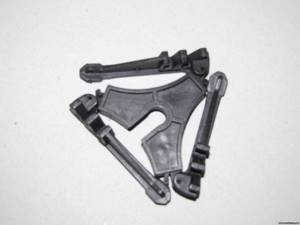
Holds up great...
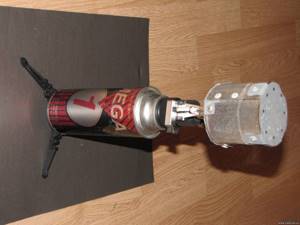
Everything seems to be perfect, there is enough heat, the burner burns perfectly, but: When testing in the fields, several minor shortcomings (inconveniences) were revealed in the vertical design of the infrared tent heater on a collet cylinder. 1. The structure itself turned out to be high. With the use of a stand, the danger of a vertical collet cylinder falling is close to zero... Although, when in the “excitement” of fishing, you can drop it with the wrong movement, which can lead to a fire... 2. The second inconvenience of a tall design is its use in a Chinese machine, which has flat walls, not vertical, so the tall heater cannot be moved to the wall. You have to install it closer to the center, which ultimately significantly reduces the working (catching) area. There is a possibility that the fishing line will get on the hot burner when fishing quickly. As a result, change the already configured and tested (catching) tackle... 3. Thirdly, during the design, the infrared heater had to be secured by means of two plates on the burner divider with a screw connection. This decision was due to the vertical design itself, so that the red-hot heater would not accidentally fall. As a result, you won’t be able to quickly remove the infrared heater; you need to take a screwdriver with you on a fishing trip and unscrew three bolts in the cold without losing the nuts in order to switch the heater to gas stove mode (for example, cook dumplings right while fishing)... But these are the shortcomings of the vertical design of the heater just for me and my fishing equipment. For those who in their forays use tents of a larger area and a slightly different design than the “Chinese” ones (for example, Scout umbrella tents) and do not bother with preparing a hot lunch directly from the hole, then the vertical solution, I think, has its advantages over the horizontal : the area and weight of the structure is smaller... Perhaps in a couple of years, when the “Chinese” one is completely unusable, I’ll buy a “Maverick” type tent; This is where a vertical heater comes in handy... And today, after analyzing it, I decided to splurge a little more and bought it for 300 rubles. burner with a horizontal cylinder arrangement.
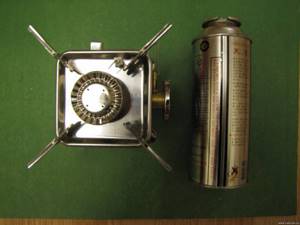
I bought a new mesh for the primary heater diffuser. By design, it had to be smaller in diameter than for the vertical one. I searched for a long time, but found it for only 20 rubles, and the handle of the strainer fell off by itself.
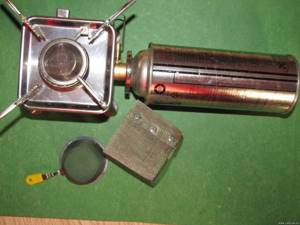
By analogy, I cut out the bottom plate from galvanized steel for an infrared heater, making small changes:
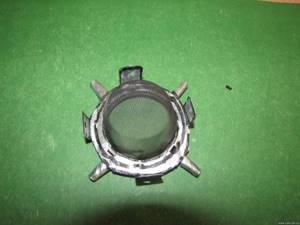
These are four longitudinal fasteners that will hold the heater head on the burner stops.
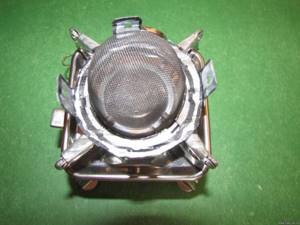
And cutouts for fastening the sphere of the first mesh.
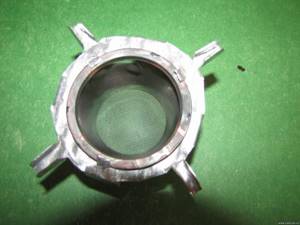
We bend them, insert the hemisphere of the mesh and bend it, fixing it. The design of the top of the heater is the same as that of the vertical one:
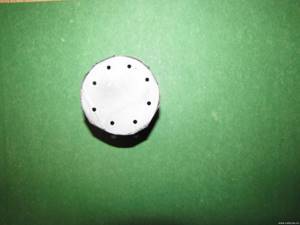
We attach it to the side mesh with rivets.
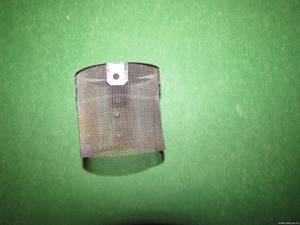
A few more steps (I made a passive heating, securing it with a plumbing clamp), and the infrared heater on a horizontal collet cylinder is almost ready. And tried...

I paid special attention to the stand for horizontal positioning of the cylinder. In the summer, to ensure its even position, shelves, chips, and pebbles are placed under it. But on ice this solution is not suitable. I cut it out of polystyrene foam left over from making fishing boxes with my own hands.
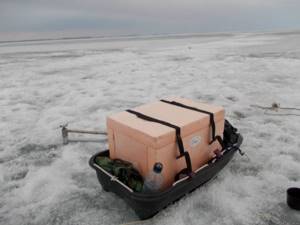
I secured the stand by attaching it to the clamp using three turns of regular electrical tape. In the end this is what happened:
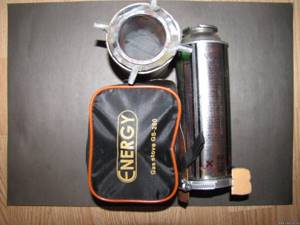
The heater in the “traveling” state, as you can see, takes up little space.
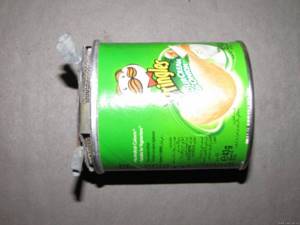
The infrared heater was protected from deformation when moving with a hard cover.
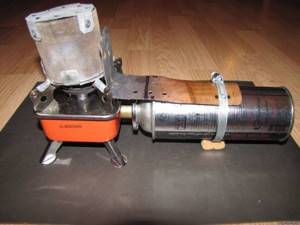
The design is assembled, it only takes a minute to assemble... The problem with the horizontal design is that the passive heater is located on top of the cylinder and its heat is irrationally used for heating. Therefore, I had to use a “thermos” - an ordinary old woolen sock - to distribute heat evenly throughout the cylinder.
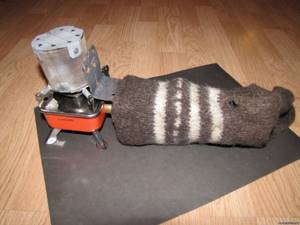
The horizontal design of the heater is conveniently placed in the “Chinese”, the effect of it is completely satisfactory... Lightweight, compact, the cylinder lasts for 3-4 hours, you can even cook food on the burner, fireproof, does not “siphon” gas, fits the size of the tent... Bottom line for me like. PS Additions regarding “carbon monoxide”... This design was designed for use in sea fishing during one daylight hours... The main criterion is minimum weight and efficiency... In the "Kitayka" in which I am using it now, there is a "dormer" window on the roof and the possibility of not complete closing of the entrance with zippers. As a result, you can quickly regulate the “flowing” ventilation in the tent.. In this way, additional access. I haven’t even used oxygen while fishing in a tent yet, because... In the final (modified) version of the design, I did not feel any fumes or smell of gas. I am sure that in this case of using a tent for up to 4 hours of continuous operation, it is completely safe. I didn’t use this design at night... I agree, if you don’t set up “flowing” ventilation, and lying at the bottom of a sealed tent, you may get burned, although this is questionable... How much carbon monoxide can be produced from burning “completely” is only 400 grams of gas???. How do you heat your fishing tent?
Gasoline heater
This is a rather ancient invention, which was successfully used by Soviet tourists. Modern manufacturers continue to produce the much-loved gasoline burners, which are in constant demand.
Gas heater option for tent
The cost of branded devices of this type starts from 5,000 rubles. You can find cheaper models. Their main advantage is reliability and power. They are able to work in the most severe frosts.
Gasoline burners do not smoke, operate quietly, and can be used indoors. Therefore, gasoline heaters will not leave the market soon. There are some drawbacks: they require certain skills from users, are easily flammable and have a number of requirements for fuel quality. In addition, low-quality gasoline can clog the burner.
Transporting such devices is not easy - gasoline smells strongly, and the heater must be packaged carefully.
What types of camping IR heaters are there?
The operating principle used by IR heaters of different modifications generally differs little from each other.
Therefore, when choosing suitable equipment, you should pay attention to the type of fuel used
Portable liquid fuel backpacking heaters have one nice additional feature: a hob located at the top of the unit. Using the installation, you can cook food without lighting a fire, heat water for tea, warm up gear and at the same time warm up a small tent.
The Russian tourist gasoline IR heater for tents Pathfinder is popular. For the convenience of customers, the company that manufactures the heater offers a fully equipped camping kit.
The package includes:
- Dishes.
- Liquid fuel cylinder.
- For ease of transportation, a travel case is included.
The heating area of gas heaters is significantly larger. Unlike gasoline burners, it is possible to heat a tent up to 15 m², in winter, when fishing or hunting. It is believed that gas devices are the most economical heaters.
Judging by the positive reviews, the most popular emitters from the following manufacturers remain:
- Pathfinder - the manufacturer is considered one of the leaders in the production of equipment for tourism and fishing. The company offers modifications: Hephaestus, Hearth, Kemp, etc. The design includes piezo ignition, a gas supply control unit and other modifications that increase comfort during operation of the device. The Pathfinder gas infrared heater, depending on the chosen model, can easily cope with heating a tent with an area of 5-15 m².
- Siberian - a special feature of the device is that the catalytic element is made of ceramic. Gas combustion occurs inside the plate. As a result, maximum operational safety is ensured. The Sibiryachka tourist heater has a power of 1.12 kW, which is enough to heat a one- or two-person tent. You can purchase a more powerful 2.3 kW model. The light weight of the product, only 1.2 kg, makes it easy to carry the burner if necessary. The Siberian burner is also used for industrial purposes, for heating garages, greenhouses, utility and agricultural premises.
All modifications can operate either from small gas cylinders or by connecting to the main pipeline. The pressure is adjusted automatically using a special reducer.
On ice
Let's start with a complex procedure. Firstly, you can’t dig the same fireplace on ice, you can’t light a fire for a long time, and secondly, fishermen often make trips hundreds of meters from the shore - they won’t carry supplies of firewood to their place, which should be enough for several hours . It is clear that you should not rely on fires - other means will be required.
Kerosene lamp. Accordingly, you will need to take with you the lamp itself, kerosene and a spare wick. Light and warmth come from it. Those who today own this rarity from the distant times of the USSR will not have any problems. For a winter tent, this device is relatively safe, the advantages are as follows:
- reliability;
- economy;
- Can be used in tents with or without floors;
- the fire is covered with glass;
- a faint odor is released.
There is no point in pouring a lot of fuel, there is literally less than half there - as long as the wick reaches the liquid and is saturated. Kerosene stoves have not been produced for a long time, but they can be found in the following places:
- shops like "Antiques";
- “Household goods” - very rarely found literally individually;
- your own attic or basement - you never know, left over from your ancestors;
- open markets, where mostly pensioners sell sometimes useful, albeit old, utensils. People call such sellers “junk sellers.”
Let's say there is a lamp, kerosene is sold in the departments of varnishes, paints and solvents, but with wicks the question is different. Previously, they were sold separately, when kerosene stoves themselves were still relevant. Some were made from natural fabric, folded in several layers and stitched.
Household candle. You don’t need anything here at all, just take a couple of candles with you and light them. For a two-person tent, one piece will be enough. It will seem that the light is too small, but the fact remains - after a while it will become warm, almost like home. You will need a small exit hole.
You can take a primus stove with you - at the same time you will have the opportunity to cook food, for example. Fishermen advise buying such production devices. But there is a drawback: regular gasoline from a gas station is prohibited for use; the device immediately deteriorates. You need appropriate fuel called “Galosha”.
Primus stoves are best used in large four-person tents, the height of which is at least 150 centimeters. These are the safety requirements for the shelters themselves, rather than for heating means.
Gas lamps and burners are also a worthy option, but again it’s a matter of fuel. You need to stock up on cylinders of high-quality gas and not skimp. Cans refilled with household fuel cannot be used. As experienced “survivalists” say, it damages equipment. By the way, we take high-power burners, somewhere under 2000 watts (2 kW).
A heater is a tourist heater that also runs on gas cylinders. As many users of such devices note, this equipment often stops working in severe frosts.
Still, candles and kerosene stoves burn much less oxygen, despite the fact that they can warm a shelter well in winter, but the leading position is occupied by an infrared gas heater, which is an ordinary ceramic tile.
Sun

To some, this point may seem even more frivolous, but in fact, the sun's rays have a very high calorific potential. Especially considering the fact that during winter in our hemisphere the Earth is at its closest distance from the Sun.
On clear, windless days - even in 30-degree frosts - you can notice the appearance of icicles on dark objects partially covered with snow. This is due to the fact that the sun heats them to a low above-zero temperature, at which the snow begins to melt. And the temperature difference here clearly exceeds 30 degrees, which is quite a lot.
The sun also slightly warms up the fishing tent, although with a very tiny part of the heat of its rays. And the lion's share of this heat is dissipated into the external space - due to reflection from the fabric and its cooling by the cold air constantly circulating outside.
Somehow it is necessary to direct the sun's heat inside the tent, but at the same time minimize its return to the outside. The prospects for this heating method are obvious, and it is quite feasible even with modern technologies. But so far there are no practical developments in this direction. Who will do this?
- Pros: free energy.
- Cons: useless in cloudy weather and at night. Well, as mentioned above, at the moment the full use of solar heat to heat a winter tent is only a theory. But in practice, it turns out that in sunny weather we have a small bonus - five degrees to the main heating source, be it a stove, kerosene stove, burner, or heater.
- Old dry fuel, produced back in Soviet times - 10 gram tablets in a package of 10 pieces.
Tents with stove
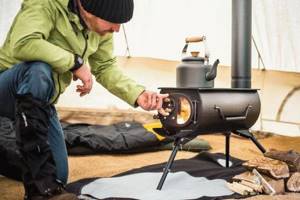
Well, the most effective way to heat a tent is to put a stove in it. This is the method used in army tents. Of course, a tourist stove has more modest dimensions than an army stove, but the essence is the same. This heating method is not suitable for a small tent. You will have to tinker with the stove, but the result will be more than worthy. There are few such products on the market, but they still exist. And some even adapt to gas and gasoline. The stove, as a rule, comes complete with a collapsible chimney. It is made of light metal and does not weigh much at all. The advantages of the stove are that it produces a lot of heat, has a simple but reliable hood design, is inexpensive, and does not require refueling.
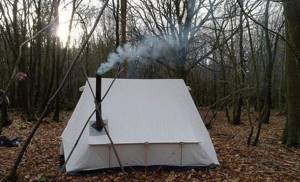
Solid fuel mini-stove
Long gone are the days when modern portable gas stoves did not exist, and primus stoves were a rarity. Fishermen at that time used homemade mini-stoves to heat their winter tents - welded from sheet iron, or hastily welded together from some metal containers. Such stoves usually ran on wood, although other solid fuels, such as coal, could also be used.
One of my acquaintances, a railway worker, an avid bream fisherman in the world, in the late 80s regularly fished on our surrounding reservoirs - the Revda city pond and the Volchikhinsky reservoir. He heated his tent with a homemade coal stove. According to his reviews, “it was so hot that I was sitting in a T-shirt.”
There were a great variety of designs for these stoves. Here, as they say, who was good at what. However, the principle was the same everywhere - a firebox, a stand (so as not to melt the ice) and a chimney pipe that went outside through a special hole in the wall of the tent, edged with non-flammable material like fiberglass. Simply put, a miniature potbelly stove.
Nowadays, mini-stoves are being pushed out of use by more efficient and compact devices for heating a tent. However, this does not mean that no one heats their tent with wood these days. In rural areas, especially in some villages far from cities, this is still a very popular method, sometimes the only possible one.
- Pros: cheap or free fuel, good calorific value.
- Disadvantages: bulky design, complete uselessness if there is no firewood in the fishing area, the need for a large amount of fuel (the aforementioned friend carried a medium bucket of coal when fishing). In addition to this, I had to periodically throw firewood into the stove, distracting myself from fishing.
How to choose a tent heater for 3 or 4 seasons
What types of heaters are best to use while camping?
When camping, only comfortable things, reliable tools and portable devices are valued - therefore, it is most convenient to use a propane device. Such devices are ideally suited for such a relatively small space as a tent for 2 reasons:
- cheap gas fuel;
- mild spot heat sufficient to warm several people in a tent.
Such gas heaters can be either for indoor use or marked “for outdoor use only.” If you are going to a campsite and there is electricity there, then it is possible to use an electric device. But since this is less common and is not exactly a “tourist” portable option, today we will not consider such devices.
Why is a propane “hot water bottle” better than a kerosene one?
Propane heaters are considered to be a step up from outdated kerosene heaters. This fact can be treated differently, because you can still find and buy a kerasine heater. Another thing is the cost of fuel. Propane is much cheaper and more convenient to use and is used to power many different appliances: heaters, grills, etc. So the choice is almost obvious.
What heat output should a heater have for different types of tents?
The answer seems obvious: the larger the tent, the more power will be required to heat it (especially if there are fewer people in it than the declared places). In any case, there is no point in purchasing a heater less than 3000 BTU. But it's not that simple. This largely depends on the type of tent itself, because they differ in shape, purpose, number of layers and seasons of use. So:
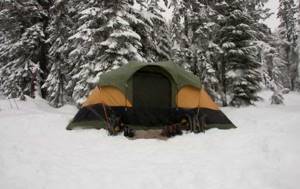
- summer tents are often thin and well-ventilated - therefore, if they are used out of season, they will require a powerful heater.
- Tents for 3 seasons (spring-summer-autumn) protect quite well from wind and rain, and warming them up is not difficult.
- 4-season tents are reliable, can be used even in cold weather, and a small heater is enough for them.
The issue of price is also important. Often, the more expensive your tent, the better the manufacturers have worked on it - and the better it can protect you from dampness and cold. The latter is achieved due to the “breathable” second layer, dense fabric, strong construction, etc. Such serious purchases assume that you will need to spend a minimum of money on additional heating. Thus, small 4-season tents assume that you can stay there in winter - without a heater or with a low-power one to maintain a comfortable temperature.
How to calculate how many gas cylinders to take on a hike?
The power of any gas (propane) heaters is measured in BTU. Knowing this indicator, you can estimate how long the gas will last: the higher the BTU, the faster the gas is consumed. Naturally, the costs will vary: it’s one thing to go on a one-day hike, and another thing to camp for 3-4 days. Some of these devices are powered only by small standard propane tanks, while others can also be connected to a larger tank. A large tank will obviously last you for the entire trip, but a small can will rarely last more than 6 hours.
Advantages and disadvantages of these devices
Expert opinion Knipovich Nikolai Mikhailovich Zoologist, hydrobiologist. I am interested in fishing at a professional level.
The first camping burner powered by liquefied gas appeared almost immediately after the end of World War II.
It was during military operations in winter conditions that the need for such structures began to be felt. Other heating methods also appeared, but the gas burner rightfully took precedence here. A number of advantages of burners for heating tents immediately became clear, which today is well known to fishermen, tourists, and the same military:
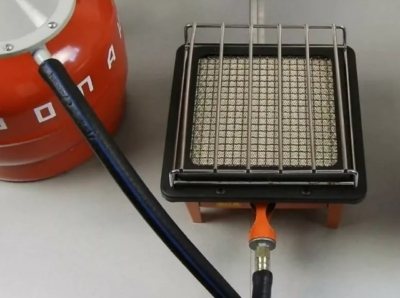
compactness and relatively light weight - in conditions of frequent crossings this is important, and the fisherman already has to carry with him many other devices, including an ice auger; the flame in the burners usually does not produce a torch, this eliminates the possibility of an unexpected fire; The burner can be used for both heating and cooking. However, experienced fishermen also note obvious disadvantages of such designs:
However, experienced fishermen also note obvious disadvantages of such designs:
- already in the cold with a temperature of minus 10 degrees, many of them, especially those made in China, may stop functioning, additional heating of the cylinders is required, but doing this over an open fire is dangerous;
- Cylinders are prohibited from being transported on airplanes; of course, they fly for winter fishing extremely rarely, but there are enthusiasts. capable of going fishing almost to Antarctica, but there is nowhere to buy fuel there;
- used cylinders that cannot be refilled are not recycled in nature; you can earn a fine for leaving them anywhere, but carrying them with you to the first trash can is also not a pleasant experience.
Expert opinion Nikolay Mikhailovich Knipovich Zoologist, hydrobiologist
I am interested in fishing at a professional level.
Modern manufacturers of burners unanimously speak about their absolute safety, but, unfortunately, accidents on ice due to their careless use continue to be recorded. So be careful and careful.
Still, a burner is much safer than a fire in a tent. All that remains is to choose a reliable design that is right for you in terms of the method of operation and cost.

